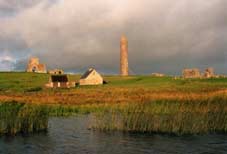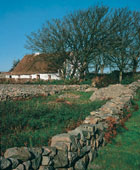|
||||||
|
Facts About the Island of Ireland
Geography
The geography of Ireland is extraordinarily varied over such a small territory. |
|
|
The West and North West are characterised by the rugged silver-grey Granite Mountains ranging along the coast. The South of the island, on the other hand, is dominated by the red Sandstone Mountains of Cork and Kerry, monolithic and brown. Between these two great formations on the Western coast is the strange limestone plateau of the Burren, with its bright greys, blues and greens. The highest mountains today are those found in the Southwest, and though they only are over 1,000 metres high, their impact is that of much greater ranges. There are mountainous areas in the East too, particularly in Counties Down and Wicklow, and a basalt plateau covers much of the Northeast. The centre of the country, with the exception of small ranges in Tipperary and around the Southern Shannon, is characterised by lush green rolling countryside. The legacy of the last Ice Age is a country of rugged bare mountains, hanging lakes, glacial valleys and the hilly landscapes of the centre of the island. |
|
|
Another striking feature of Ireland's geography is the extent of peat bog - which covers nearly a fifth of the entire country. These bogs often present very dramatic landscapes, with strangely shaped trees standing amongst multi-toned patterns of brown and purple. The turf, a legacy of the rapid warming of the country following the last Ice Age, is still widely worked. The lack of forest cover in Ireland is also immediately noticeable. Although Ireland's sparse woodlands cover just 6% of the land compared to Germany, for example, where forest cover is nearly 25%, primeval forests can still be found, consisting of ancient oak and the great Scots Pine. Most forests are more recent, mainly of Sitka spruce.
|
|
|
Language
Irish (Gaelic) and English are the two official languages of Ireland. Irish is also an official language of the European Union. While it is the native language of Ireland and widely taught in schools, English is spoken by everyone. There are however regions called 'Gaeltachts' where Irish is used daily as the vernacular of the locals. Gaeltachts are predominately located in the West, around Galway, but there are others in Kerry and Cork, while there is one in Rathcairn, Co. Meath in the midlands and Ring, Co. Waterford, on the East coast. The number of 'native speakers' has been in decline since the Great Famine of the last century and currently stands at around 80,000. This number is on the increase again, thanks to a revival in interest in the language. Several radio stations and even a television station (TG4) have helped this recovery.
Official documents, street and road signs are bilingual. Some Irish words you are likely to encounter are Fir (gentlemen), Mná (ladies), Gardaí (police) telefón (telephone), Siopa (shop) and Oifig an Phoist (post office).
Ulster Scots, spoken in Northern Ireland, has in many ways shared the same historical fate as the Irish language. Thankfully, it too is undergoing something of a revival, being taught in schools and classes for adults keen to explore another facet of their national identity. |
|


